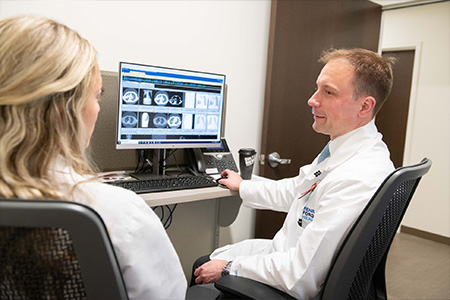Screening Provides Hope
Vic Thompson is cancer-free after early-stage lung cancer is detected and removed.
 If you’ve received a diagnosis of lung cancer, your doctor may recommend surgery to remove the cancerous tissue as part of your treatment plan. Our lung cancer team at Henry Ford Cancer includes thoracic surgeons with extensive experience in every type of lung cancer surgery.
If you’ve received a diagnosis of lung cancer, your doctor may recommend surgery to remove the cancerous tissue as part of your treatment plan. Our lung cancer team at Henry Ford Cancer includes thoracic surgeons with extensive experience in every type of lung cancer surgery.
We are one of only eight nationally recognized robotic surgery epicenters, which means we teach doctors across the country how to use these highly precise, minimally invasive surgical techniques. We use minimally invasive surgical techniques whenever possible to preserve your healthy lung tissue while we remove and destroy your lung cancer.

Vic Thompson is cancer-free after early-stage lung cancer is detected and removed.
We specialize in two minimally invasive approaches for lung cancer surgery:
Compared to traditional open surgery for lung cancer, these minimally invasive techniques offer faster recoveries, shorter hospital stays and smaller incisions with minimal scarring. Watch the video below to learn more about the benefits of minimally invasive lung cancer surgery with our team.
Your doctor will recommend a particular type of lung cancer surgery based on several key factors, including:
You and your doctor will decide together which type of surgery is right for you. The types of lung cancer surgery we offer include:
You may need chemotherapy and/or radiation therapy as part of your treatment plan — either before surgery to shrink cancerous tissue or afterward to destroy any cancerous tissue that may remain. You and your doctor will discuss what approach is right for you.
If we can’t access your tumor through minimally invasive approaches, your doctor may need to perform surgery in order for us to take a tissue sample (biopsy) for testing and staging of your tumor. Watch the video below to learn more about surgery for diagnosing lung cancer.
We use cookies to improve your website experience. By using this site, you agree to our Terms of Use. Read our Internet Privacy Statement to learn what information we collect and how we use it.